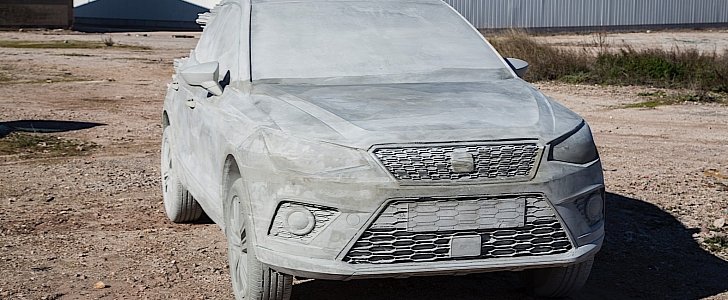Millennia from now, one of our descendants visiting Cascais, Portugal, will unearth a solid block of stone, shaped in a weird way. The historian will dig through archives and mud, and pinpoint the block of stone to the 21st century.
That piece of stone, which in our time lies in the Urban Contemporary Art Museum in Cascais, is a cement sculpture meant to celebrate the Arona, a means of transport called SUV introduced by a Spanish company called SEAT way back in 2017.
The work of ark belongs to a Portuguese artist who went by the name Alexandre Farto. Records show it took the man about a year to complete his work: three months were spent on designing the initial mold in 3D, and the rest for the actual build.
The historian learns that the block of stone is no stone at all. It is in fact a block of a material called cement, intensely used in the past mainly in construction work. For the Arona, 15 tons of the material were used, alongside steel, silicone and fiberglass.
The historian digs up the artist’’s last will and testament, buried right next to the sculpture: his desire was that the sculpture is unearthed a century or so after its creation.
The historian does a quick calculus. It’s been one thousand years.
The sculpture is dull. Having spent eons under the ground, it lacks any color to it. Weird shapes, like circular blocks of stone, sit in all four corners. Something like eyes are carved at what appears to be the front, as is a strange sign, resembling characters from the historian's favorite vintage game, Pac Man, heading in opposite directions.
At the back, the Arona looks shredded, as if destroyed in a blast. The historian wonders if this is a relic from the Descent.
Scraping away at centuries of deposits on the cement Arona, the historian uncovers its name: Tangible.
The work of ark belongs to a Portuguese artist who went by the name Alexandre Farto. Records show it took the man about a year to complete his work: three months were spent on designing the initial mold in 3D, and the rest for the actual build.
The historian learns that the block of stone is no stone at all. It is in fact a block of a material called cement, intensely used in the past mainly in construction work. For the Arona, 15 tons of the material were used, alongside steel, silicone and fiberglass.
The historian digs up the artist’’s last will and testament, buried right next to the sculpture: his desire was that the sculpture is unearthed a century or so after its creation.
The historian does a quick calculus. It’s been one thousand years.
The sculpture is dull. Having spent eons under the ground, it lacks any color to it. Weird shapes, like circular blocks of stone, sit in all four corners. Something like eyes are carved at what appears to be the front, as is a strange sign, resembling characters from the historian's favorite vintage game, Pac Man, heading in opposite directions.
At the back, the Arona looks shredded, as if destroyed in a blast. The historian wonders if this is a relic from the Descent.
Scraping away at centuries of deposits on the cement Arona, the historian uncovers its name: Tangible.









